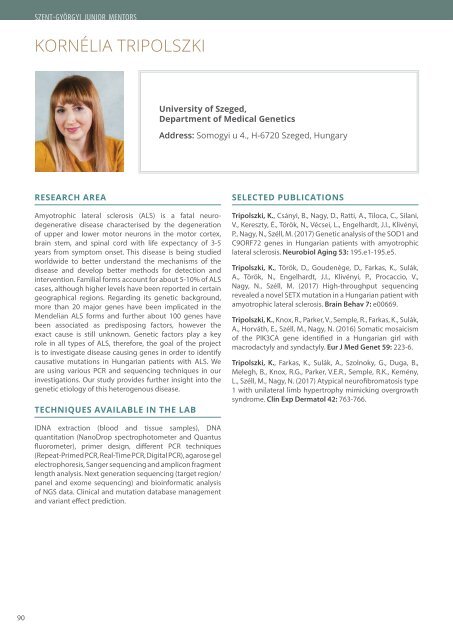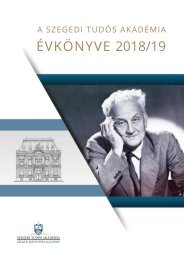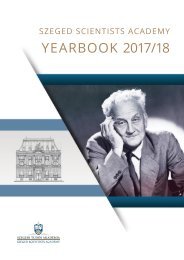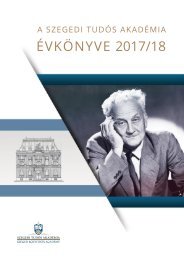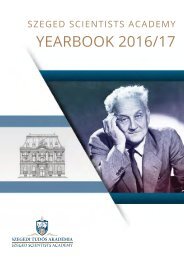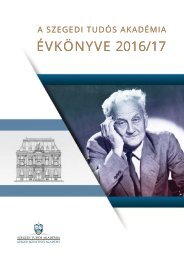You also want an ePaper? Increase the reach of your titles
YUMPU automatically turns print PDFs into web optimized ePapers that Google loves.
SZENT-GYÖRGYI JUNIOR MENTORS<br />
KORNÉLIA TRIPOLSZKI<br />
University of Szeged,<br />
Department of Medical Genetics<br />
Address: Somogyi u 4., H-6720 Szeged, Hungary<br />
RESEARCH AREA<br />
Amyotrophic lateral sclerosis (ALS) is a fatal neurodegenerative<br />
disease characterised by the degeneration<br />
of upper and lower motor neurons in the motor cortex,<br />
brain stem, and spinal cord with life expectancy of 3-5<br />
years from symptom onset. This disease is being studied<br />
worldwide to better understand the mechanisms of the<br />
disease and develop better methods for detection and<br />
intervention. Familial forms account for about 5-10% of ALS<br />
cases, although higher levels have been reported in certain<br />
geographical regions. Regarding its genetic background,<br />
more than 20 major genes have been implicated in the<br />
Mendelian ALS forms and further about 100 genes have<br />
been associated as predisposing factors, however the<br />
exact cause is still unknown. Genetic factors play a key<br />
role in all types of ALS, therefore, the goal of the project<br />
is to investigate disease causing genes in order to identify<br />
causative mutations in Hungarian patients with ALS. We<br />
are using various PCR and sequencing techniques in our<br />
investigations. Our study provides further insight into the<br />
genetic etiology of this heterogenous disease.<br />
TECHNIQUES AVAILABLE IN THE LAB<br />
SELECTED PUBLICATIONS<br />
Tripolszki, K., Csányi, B., Nagy, D., Ratti, A., Tiloca, C., Silani,<br />
V., Kereszty, É., Török, N., Vécsei, L., Engelhardt, J.I., Klivényi,<br />
P., Nagy, N., Széll, M. (2017) Genetic analysis of the SOD1 and<br />
C9ORF72 genes in Hungarian patients with amyotrophic<br />
lateral sclerosis. Neurobiol Aging 53: <strong>19</strong>5.e1-<strong>19</strong>5.e5.<br />
Tripolszki, K., Török, D., Goudenège, D., Farkas, K., Sulák,<br />
A., Török, N., Engelhardt, J.I., Klivényi, P., Procaccio, V.,<br />
Nagy, N., Széll, M. (2017) High-throughput sequencing<br />
revealed a novel SETX mutation in a Hungarian patient with<br />
amyotrophic lateral sclerosis. Brain Behav 7: e00669.<br />
Tripolszki, K., Knox, R., Parker, V., Semple, R., Farkas, K., Sulák,<br />
A., Horváth, E., Széll, M., Nagy, N. (2016) Somatic mosaicism<br />
of the PIK3CA gene identified in a Hungarian girl with<br />
macrodactyly and syndactyly. Eur J Med Genet 59: 223-6.<br />
Tripolszki, K., Farkas, K., Sulák, A., Szolnoky, G., Duga, B.,<br />
Melegh, B., Knox, R.G., Parker, V.E.R., Semple, R.K., Kemény,<br />
L., Széll, M., Nagy, N. (2017) Atypical neurofibromatosis type<br />
1 with unilateral limb hypertrophy mimicking overgrowth<br />
syndrome. Clin Exp Dermatol 42: 763-766.<br />
IDNA extraction (blood and tissue samples), DNA<br />
quantitation (NanoDrop spectrophotometer and Quantus<br />
fluorometer), primer design, different PCR techniques<br />
(Repeat-Primed PCR, Real-Time PCR, Digital PCR), agarose gel<br />
electrophoresis, Sanger sequencing and amplicon fragment<br />
length analysis. Next generation sequencing (target region/<br />
panel and exome sequencing) and bioinformatic analysis<br />
of NGS data. Clinical and mutation database management<br />
and variant effect prediction.<br />
90


